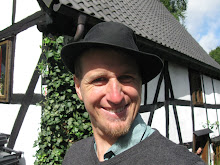
Yes, it’s been a while since my last entry. It’s not that I’ve been uninspired, in fact, I’ve been doing a lot of writing*. It’s just that I’ve been leading a rather pedestrian life, literally. My bike is in the garage here in Wirksworth and some days I don’t leave the house. Here in Wirksworth, an old town of 9000 in the limestone quarry part of the Midlands, the focus has really been family. With my Nana and Grandad (ninety-five and ninety-two) it’s flavoured by the numerous cups of tea, the stories of time spent in Malawi in 50’s, 60’s and 70’s, the bus trips to villages up the valley of the ‘mighty Derwent’. Helping them with some small challenges – opening fiddly juice containers and pesky email attachments - is a pleasure. Aunty Rosie and Uncle Graham are consistent with hugs and literature suggestions. Cousins Elliot and Alexander show me how to party – Wirksworth style. They have strange rules for pool here. And a wah-wah pedal! I also earn some pounds helping renovate houses for a local.
You may have heard of the flooding in nearby Yorkshire. Intense. Six people have died and there’s been around a billion pounds of damage. (Not nearly as bad as the floods in Pakistan, though) The rain definitely got to Derbyshire, but don’t fret, pet, we’re safe. Perched on a hill, it all drains away from Wirksworth.
What’s it like living here, in the midst of England’s countryside? You guessed it, it’s quaint. Quaint little “pooubs” quaint old shop-keepers who call everyone “duck”. Quaint houses from the local stone, strewn higgledy piggledy around the hills. And people probably think I’m quaint. Having conversations with people I pass myself off as normal; it’s the small interactions with strangers that I fumble my way through. I still haven’t completely weaned myself off the very kiwi eyebrow-lift, chin-tilt greeting and I pay the price in blank stares. And when people say “y’right?” over here, it’s a warm greeting, as Mel tried to teach me, not an anxious probe. And sometimes, like when I make jokes to strangers at the tennis court, I think maybe I’m just being too friendly, even for Wirksworth.
Even the monumental and historic buildings are quaint. I visit Cromford, a village famous for being the 1771 site of Lancashire entrepreneur Richard Arkwright’s deployment of mechanised cotton-spinning and the factory system. Some call it the birthplace of the Industrial Revolution. Most of the ”mills” (really factory buildings) still stand, large they may be, but (see photo) still pink and cute. Not like the working conditions. Surplus labour from the dying lead industry was exploited, and children crouched under the water-powered spinning machines to clean or “scavenge” any debris. If you weren’t bang on time for your twelve-hour shift, you couldn’t work any of the day. Those who know about my punctuality can envisage my potential cotton spinning pay-check. Other factories were even harsher, apparently

It really is a strange place to be spinning cotton. Several thousand miles from your nearest cotton field, it was only intense secrecy about industrial practices (and the protective measures of the British government) that meant the industrial revolution happened here, rather than closer to the cotton itself.
Arkwright had one of his mills destroyed early on by anti-mechanisation rioters (hooray!) and promptly developed a militia and a cannon to guard this one. Oh, yeah, I was talking about quaint. Get this. Arkwright picked the relatively remote Cromford for his project for several reasons – but how was this foreign guy familiar with the place? He was a wig maker, and travelled to large gatherings to gather the human hair for his wigs. The story is that nearby Wirksworth had a good deal of country fairs, and thus a good supply of hair. Arkwright came for the hair, but he stayed for the prime factory location!
*If anyone is keen on reading my new Roald Dahl-(think Tales of the Unexpected, not BFG)-esque short story, let me know, and I’ll swing you an email copy.




